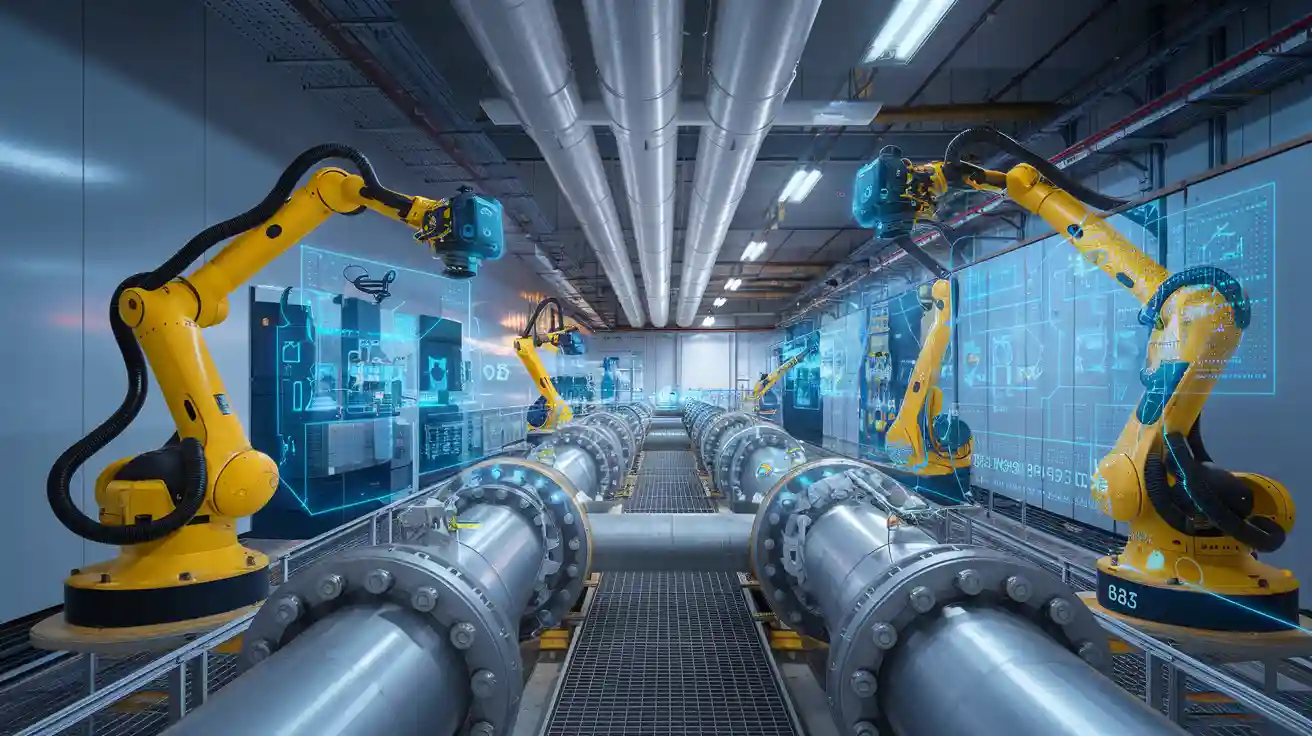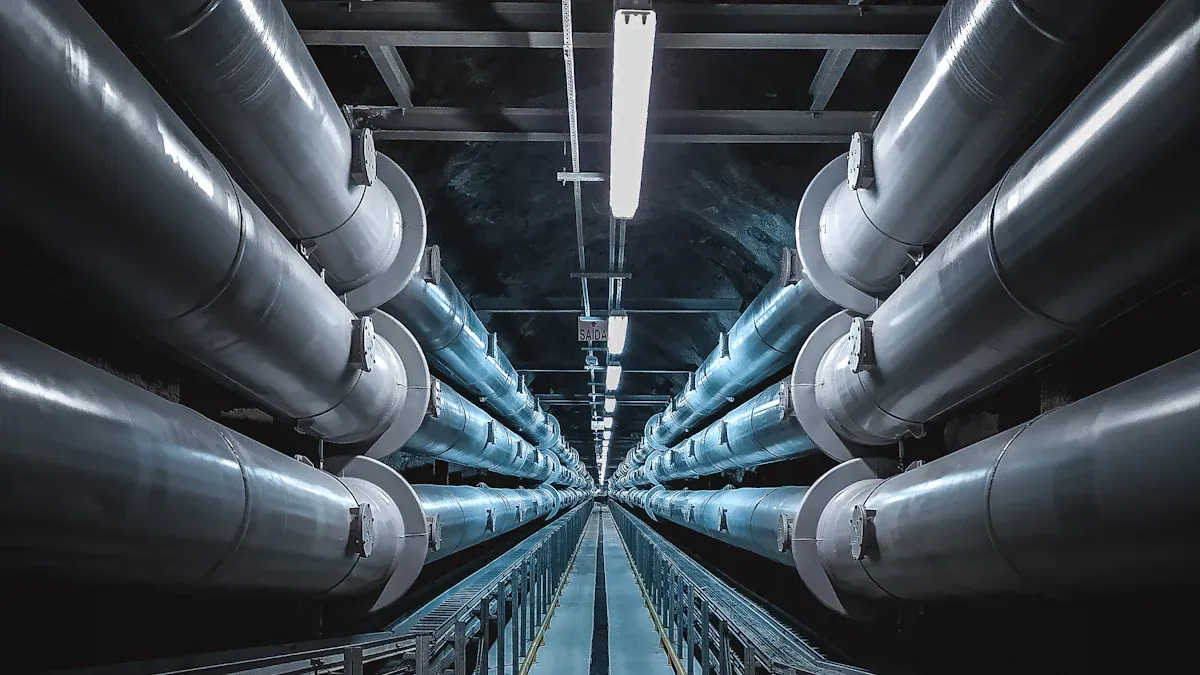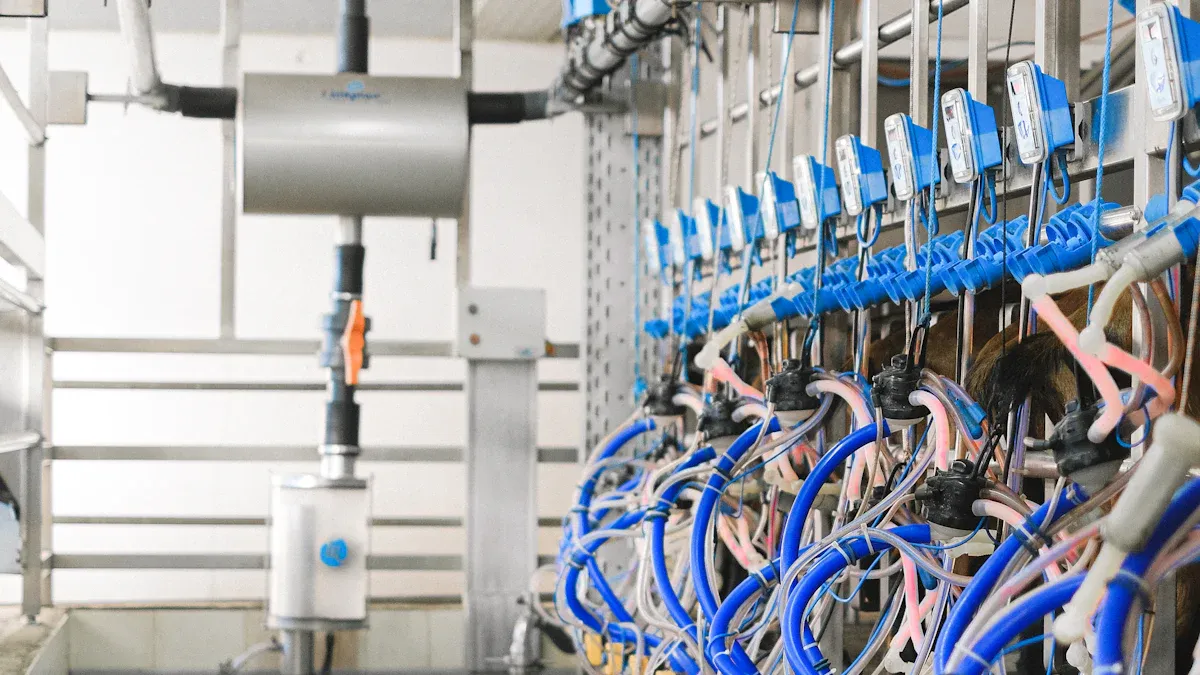Exploring the Role of Machine Vision in Pipeline Quality Control

Imagine a system that inspects pipelines with unmatched speed and precision. This is what machine vision offers. It enhances safety by detecting flaws invisible to the human eye. You benefit from its ability to improve efficiency by over 30% and reduce inspection time from minutes to seconds. With a quality assurance pipeline machine vision system, you achieve 99% accuracy in defect detection, ensuring safer operations and higher product yield. Machine vision transforms pipeline quality assurance into a faster, more reliable process.
Key Takeaways
- Machine vision helps check pipelines by spotting hidden problems. This makes them safer and work better.
- Automated checks are faster, taking seconds instead of minutes. This boosts work speed and reduces delays.
- Live data processing finds issues right away. This helps fix problems quickly and keeps things running smoothly.
- Using machine vision for repairs can cut costs by 30%. It also makes equipment last longer and saves resources.
- Adding machine vision to current systems makes work easier. But workers need training to use it well.
Understanding the Quality Assurance Pipeline Machine Vision System
What is a Machine Vision System
A machine vision system uses advanced imaging technology to inspect and analyze objects automatically. It combines cameras, lighting, and software to capture and process images. You can think of it as a digital eye that detects flaws and ensures quality in industrial processes. For pipeline inspection, it identifies defects, monitors surface conditions, and verifies compliance with standards.
Key components of a machine vision system include:
- Camera: Captures high-resolution images for analysis.
- Illumination: Provides optimal lighting for accurate image capture.
- Lenses: Focuses images to ensure clarity and precision.
- Vision Processors: Runs algorithms to detect defects.
- Software: Analyzes images and makes decisions based on predefined criteria.
These components work together to deliver reliable and consistent results, making the system indispensable for pipeline quality assurance.
Core Functionalities of Machine Vision in Quality Control
Machine vision systems perform several critical tasks in pipeline inspection:
- Seal presence and positioning: Ensures seals are present and correctly aligned.
- Defect detection: Identifies cracks, corrosion, and other flaws in real time.
- Surface analysis: Monitors the quality of materials used in pipelines.
- Real-time communication: Shares inspection data with control systems instantly.
- Flexibility: Adapts to new inspection requirements as technology evolves.
These functionalities improve accuracy and reduce the risk of defects, ensuring pipelines meet industry standards.
How Machine Vision Differs from Traditional Inspection Methods
Traditional inspection methods rely heavily on manual labor and visual checks. These methods often miss subtle defects and take longer to complete. Machine vision systems, on the other hand, offer unmatched precision and speed. They use high-performance cameras and advanced software to detect flaws invisible to the human eye.
Unlike manual inspections, machine vision systems provide consistent results and eliminate human error. They also integrate seamlessly with Industry 4.0 technologies, enabling remote monitoring and predictive maintenance. This makes them a superior choice for modern pipeline quality assurance.
Applications of Machine Vision in Oil Pipeline Inspection

Defect Detection in Pipeline Materials
Machine vision systems excel at identifying defects in pipeline materials. These systems use high-resolution cameras and advanced algorithms to detect cracks, dents, and other irregularities. You can rely on their precision to spot flaws that might go unnoticed during manual inspections. This ensures that only high-quality materials are used in pipeline construction and maintenance.
- Key Benefits of Defect Detection:
- Early identification of material flaws prevents costly repairs.
- Automated defect detection minimizes human error.
- Consistent quality inspection improves pipeline reliability.
Machine vision systems also support automated product inspection, which enhances efficiency. By integrating these systems into your operations, you can achieve faster and more accurate inspections, reducing downtime and improving overall productivity.
Corrosion Monitoring and Surface Analysis
Corrosion is a significant challenge in oil pipeline inspection. Machine vision systems provide a reliable solution for monitoring and analyzing pipeline surfaces. These systems use advanced imaging techniques to detect corrosion early, helping you address issues before they escalate.
Research shows that machine learning techniques combined with machine vision systems achieve high accuracy in corrosion detection. A multi-step process involving data preprocessing and feature engineering has demonstrated an average accuracy of over 82% in predicting corrosion logs. This level of precision ensures that your pipelines remain safe and operational.
Tip: Regular corrosion monitoring with machine vision systems reduces safety risks and maintenance costs. It also extends the lifespan of your pipelines, saving you money in the long run.
Real-Time Inspection and Automated Reporting
Real-time inspection is one of the most valuable features of machine vision systems. These systems capture and analyze images at high speeds, often processing data in less than 20 milliseconds. This capability allows you to identify defects and make decisions instantly, ensuring uninterrupted operations.
Automated reporting further enhances the value of machine vision systems. By logging inspection data, these systems provide detailed insights into pipeline conditions. You can use this information to identify recurring issues and improve upstream processes.
- Advantages of Real-Time Inspection and Reporting:
- High-speed inspections reduce production delays.
- Automated reporting ensures traceability and compliance.
- Early defect detection minimizes material waste.
- Cloud-based analytics enable remote monitoring and decision-making.
For example, facilities using machine vision systems have reported significant reductions in false positives and material waste. These systems also eliminate the need for manual classification, allowing you to maintain production speed while improving accuracy.
Benefits of Machine Vision in Pipeline Quality Control

Improved Accuracy and Precision
Machine vision systems redefine accuracy in pipeline inspections. You can rely on their ability to detect even the smallest defects that manual inspections might overlook. These systems use high-resolution cameras and advanced algorithms to identify issues like hairline fractures and minor leaks.
- Key Examples of Improved Accuracy:
- Automated computer vision systems deployed in remote areas enhance inspection precision.
- A major oil company prevented a potential spill by detecting a minor leak early using machine vision technology.
- Continuous real-time monitoring ensures early detection of issues, enabling targeted maintenance.
Machine vision based quality control eliminates guesswork. It ensures pipelines meet stringent industry standards, reducing risks and improving reliability.
Enhanced Efficiency and Reduced Inspection Time
Efficiency is a cornerstone of machine vision based quality control. By automating inspections, you reduce manual labor and streamline operations. High-speed systems process thousands of items per minute, cutting inspection time significantly.
- Statistical Evidence Supporting Efficiency:
- Automated inspections lower production costs and enhance operational efficiency.
- Advanced algorithms detect defects faster than human inspectors, ensuring swift issue identification.
These systems allow you to maintain accuracy while accelerating the inspection process. Faster inspections mean fewer delays, enabling you to meet deadlines and optimize productivity.
Increased Safety for Workers and Operations
Safety is paramount in pipeline inspections, and machine vision systems excel in this area. By using drones equipped with high-resolution cameras, you minimize the need for workers to perform hazardous manual inspections.
- Safety Benefits of Machine Vision:
- Drones improve inspection efficiency by up to 80%, allowing quicker assessments of pipeline conditions.
- High-resolution imaging detects subtle defects like corrosion and hairline fractures, reducing operational risks.
- Real-time data processing flags anomalies instantly, enabling faster responses to potential hazards.
Machine vision based quality control not only protects workers but also ensures safer operations. You reduce the likelihood of accidents and maintain compliance with safety regulations.
Cost Savings Through Predictive Maintenance
Predictive maintenance powered by machine vision offers significant cost savings for pipeline quality control processes. By identifying potential issues before they escalate, you can avoid expensive repairs and downtime. This advanced system for quality control ensures that your operations run smoothly while reducing unnecessary expenses.
One of the key advantages of predictive maintenance is its ability to minimize reactive and preventive maintenance costs. Reactive maintenance often leads to unplanned downtime and higher repair costs. Preventive maintenance, while proactive, can still result in unnecessary part replacements and labor expenses. Predictive maintenance, on the other hand, uses machine vision solutions to monitor pipeline conditions in real time. This allows you to address issues only when necessary, optimizing resources and reducing waste.
Did you know? Companies using predictive maintenance can lower maintenance costs by up to 30% and increase equipment uptime by 20-30%.
Economic Impact of Predictive Maintenance
The economic benefits of predictive maintenance are well-documented. The table below highlights some key statistics:
| Statistic | Value |
|---|---|
| Savings over preventive maintenance | 8-12% |
| Savings compared to reactive maintenance | up to 40% |
| Global predictive maintenance market (2022) | $5.5 billion |
| Projected CAGR (2022-2028) | 17% |
| Reduced parts inventory savings | 15-20% |
| Lower maintenance labor costs | 25-30% reduction |
| Extended equipment lifespan | 20-40% increase |
| Energy savings | 5-15% |
These figures demonstrate the transformative potential of predictive maintenance. By adopting machine vision assisted quality control, you can achieve substantial savings while improving operational efficiency.
Long-Term Benefits for Product Quality Assurance
Predictive maintenance also enhances product quality assurance. By detecting errors early, you can prevent defective materials from entering the production process. This reduces waste and ensures that your final products meet industry standards. Custom machine vision solutions play a crucial role in this process by providing accurate and reliable error detection.
- Key Benefits of Predictive Maintenance:
- Reduces unplanned downtime, saving time and money.
- Extends the lifespan of equipment, lowering replacement costs.
- Improves energy efficiency, reducing operational expenses.
- Enhances quality control processes, ensuring consistent product quality.
For example, facilities that implement predictive maintenance often report a 15-20% reduction in parts inventory costs and a 25-30% decrease in maintenance labor expenses. These savings, combined with improved error detection and streamlined quality control processes, make predictive maintenance an essential strategy for modern pipeline operations.
By leveraging machine vision solutions, you can transform your approach to maintenance and quality control. This not only saves money but also ensures safer and more reliable pipeline operations.
Challenges in Implementing a Machine Vision System
Integration with Existing Systems and Workflows
Integrating machine vision systems into existing pipeline inspection workflows presents unique challenges. Many systems are designed with rigid architectures, making them less adaptable to diverse applications. You may find it difficult to modify hardware to suit specific inspection needs. Software programming adds another layer of complexity. Operators often need to manually adjust algorithms, which can be challenging without coding expertise.
Reconfiguration requirements further complicate integration. Each time you inspect a different product or defect type, the system may need adjustments. This process can slow down operations and increase the risk of errors.
Tip: Collaborate with experienced integrators to streamline the setup process and reduce downtime.
| Challenge Type | Description |
|---|---|
| Hardware Rigidity | Most Vision Inspection Systems (VIS) are designed for specific applications, leading to low flexibility and rigid architectures. |
| Software Programming | Manual low-coding activities are required to adapt algorithms, which is challenging for operators lacking programming expertise. |
| Reconfiguration Needs | The need for reconfiguration to accommodate different products and defect types adds complexity to the integration process. |
Environmental Factors Impacting Performance
Environmental conditions can significantly affect the performance of machine vision systems. Harsh weather, extreme temperatures, and poor lighting can interfere with image capture. For example, pipelines in remote areas often face challenges like dust, moisture, and vibrations. These factors can reduce the accuracy of defect detection and surface analysis.
You may also encounter issues with system calibration. Changes in environmental conditions require frequent recalibration to maintain precision. This adds to the workload and increases operational costs.
Note: Using robust equipment and protective enclosures can mitigate environmental impacts and improve system reliability.
Initial Investment and Cost Considerations
Implementing machine vision systems involves substantial upfront costs. You need to invest in hardware, software, and integration processes. These expenses can be daunting, especially for small businesses. However, automation and improved decision-making can offset these costs over time.
Ongoing expenses like maintenance and updates also contribute to the financial commitment. You must plan for personnel training and data infrastructure to ensure smooth operations. A comprehensive budget plan helps balance these costs against expected returns. Evaluating return on investment (ROI) through established KPIs is essential for long-term success.
Did you know? Companies that adopt machine vision systems often achieve significant savings through reduced labor costs and improved quality control processes.
Training and Expertise Requirements
Implementing a machine vision system requires skilled personnel. You need to ensure that your team has the necessary training to operate and maintain the system effectively. Without proper expertise, the system may not deliver optimal results, leading to inefficiencies and potential errors.
Training programs should focus on both hardware and software aspects. Operators must understand how to calibrate cameras, adjust lighting, and configure lenses for different inspection scenarios. Familiarity with the system's software is equally important. Your team should know how to set up algorithms, analyze data, and troubleshoot issues. Hands-on training sessions can help bridge the gap between theoretical knowledge and practical application.
Tip: Partnering with the system manufacturer for training ensures your team receives expert guidance tailored to your specific needs.
You also need to consider the level of expertise required for system maintenance. Routine tasks like cleaning lenses and updating software can be handled by trained operators. However, complex issues may require the assistance of specialists. Investing in advanced training for key personnel can reduce downtime and improve the system's reliability.
A well-trained team not only maximizes the system's performance but also ensures a smoother integration into your workflow. By prioritizing training and expertise, you can unlock the full potential of your machine vision system and achieve consistent, high-quality results.
Machine vision technology is revolutionizing pipeline quality control by delivering unmatched precision and efficiency. Industries like automotive, pharmaceuticals, and oil and petroleum increasingly rely on these systems to enhance safety and product quality. The integration of AI, drones, and real-time analytics is shaping the future of inspections. These advancements allow you to predict issues, reduce risks, and optimize operations. As machine vision evolves, it promises a future where inspections are faster, safer, and more reliable, ensuring pipelines meet the highest standards.
FAQ
What makes computer vision systems better than manual inspections?
Computer vision systems provide unmatched precision and speed. They detect defects invisible to the human eye and deliver consistent results. Unlike manual inspections, they operate in real-time, reducing errors and improving overall quality. These systems also integrate seamlessly with automation, enhancing efficiency and reliability in pipeline quality control.
How do computer vision systems ensure real-time defect detection?
Computer vision systems use high-speed cameras and advanced algorithms to analyze images instantly. This real-time capability allows you to identify defects as they occur, ensuring immediate action. By processing data in milliseconds, these systems maintain the quality of inspections without disrupting operations, making them invaluable for modern industries.
Are computer vision systems cost-effective for small businesses?
While the initial investment may seem high, computer vision systems save costs in the long run. They reduce labor expenses, improve inspection quality, and minimize downtime. Predictive maintenance powered by these systems prevents costly repairs. For small businesses, the efficiency and real-time insights they offer outweigh the upfront costs.
Can environmental factors affect the performance of computer vision systems?
Yes, environmental conditions like dust, moisture, and poor lighting can impact performance. However, using robust equipment and protective enclosures mitigates these challenges. Regular calibration ensures consistent quality, even in harsh environments. These measures help maintain the reliability of real-time inspections in diverse settings.
How do computer vision systems contribute to predictive maintenance?
Computer vision systems monitor pipeline conditions in real-time, identifying potential issues before they escalate. This predictive approach reduces unplanned downtime and maintenance costs. By ensuring consistent quality and extending equipment lifespan, these systems optimize resources and enhance operational efficiency, making them a cornerstone of modern maintenance strategies.
See Also
Investigating Machine Vision Applications in Steel Production
The Importance of Image Recognition in Quality Control Systems
Improving Product Quality Through Surface Inspection Technologies
